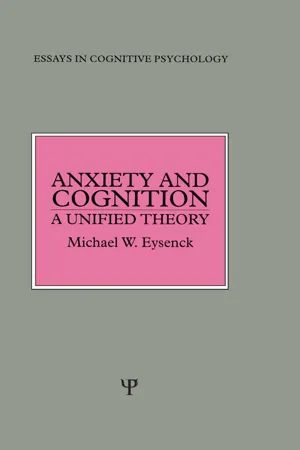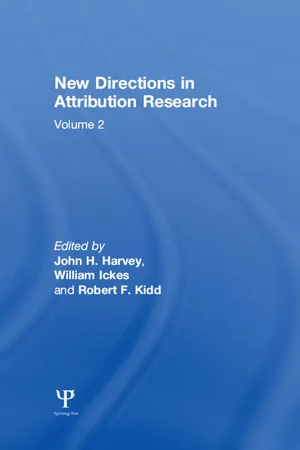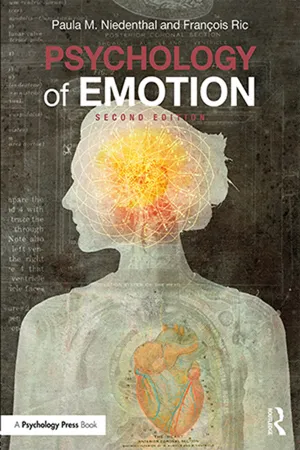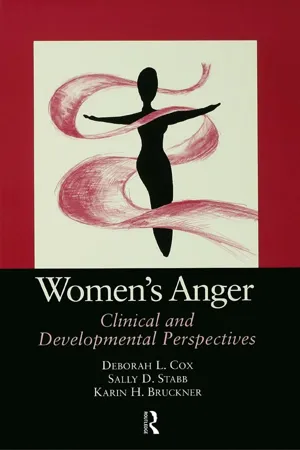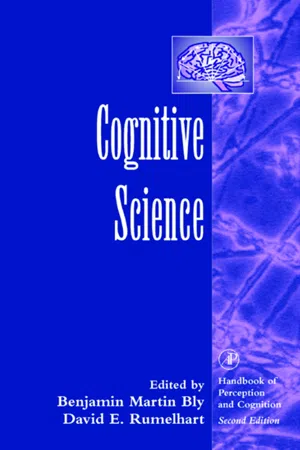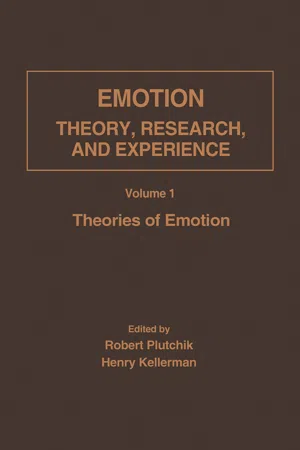Psychology
Schachter-Singer Theory
The Schachter-Singer Theory, also known as the two-factor theory of emotion, proposes that emotions are the result of both physiological arousal and cognitive interpretation of that arousal. According to this theory, the experience and labeling of emotions depend on the individual's interpretation of the physiological arousal in a given situation. This theory emphasizes the role of cognitive processes in shaping emotional experiences.
Written by Perlego with AI-assistance
Related key terms
1 of 5
7 Key excerpts on "Schachter-Singer Theory"
- eBook - PDF
What is Psychology?
Foundations, Applications, and Integration
- Ellen Pastorino, Susann Doyle-Portillo, Ellen Pastorino(Authors)
- 2021(Publication Date)
- Cengage Learning EMEA(Publisher)
Cengage Learning reserves the right to remove additional content at any time if subsequent rights restrictions require it. CHAPTER 5 Motivation and Emotion 218 emotional state. If the confederate was angry, then the participants interpreted their arousal as part of a negative emotional state. The results confirmed Schachter and Singer’s predictions. The mood of the informed participants was not influenced by the confederate’s mood, but the con- federate did influence the mood of the uninformed participants. The uninformed participants who waited with the angry confederate reported feeling angrier than did the informed participants. The uninformed participants who waited with the happy confederate reported feeling happier than did the informed participants. It appears that the uninformed participants used the situation to help them figure out their own emotions. Although Schachter and Singer and others (Brown & Curhan, 2013) have produced experimental evidence to support the notion that arousal can affect our emotional states, the two-factor theory has not stood the test of time well. Decades of research on the two-factor theory show that there is little reason to believe that emotions require physiological arousal or that emotions necessarily come from labeling unexplained physiological arousal. For example, people who’ve been given beta-blocking drugs that prevent autonomic nervous system arousal (i.e., a fight or flight reaction) still report experiencing emotions that are relevant to their current environment (Reisenzein, 1983). Despite doubts about the two-factor theory, Schachter and Singer’s contribution to the study of emotion is significant. They introduced the idea that cognition plays an important role in emotion, and many theorists recognize that thoughts are part of the emotional experience. 5.4.4 Lazarus’s Cognitive-Mediational Theory of Emotion According to Richard Lazarus (1995), cognition is the most important part of emotion. - eBook - ePub
Anxiety and Cognition
A Unified Theory
- Michael Eysenck(Author)
- 2014(Publication Date)
- Psychology Press(Publisher)
This criticism is generally valid. However, some evidence for distinctive patterns is available in the fact that smiling is associated with happiness, crying with misery, and running away with anxiety. There is also evidence that emotions differ in terms of autonomic activity. Ekman, Levenson, and Friesen (1983) asked their subjects to recreate the facial expressions of anger, fear, sadness, happiness, surprise, and disgust. Anger, fear, and sadness all produced much greater increases in heart rate than did happiness, surprise, or disgust. Hand temperature increased considerably with anger, and it increased slightly with happiness, but it decreased with disgust. The existence of differential physiological patterning among emotions does not, of course, demonstrate that distinctive emotional feelings depend on such physiological differences.Schachter’s Two-Factor TheoryOne of the most influential theories of emotion was put forward by Schachter and Singer (1962) and Schachter (1964). In some ways, their two-factor theory can be regarded as a development and extension of the James-Lange theory. As can be seen in Fig. 2.1 , emotional experience depends on three factors. First, the situation must be interpreted as being an emotional one. Second, and reminiscent of the James-Lange theory, there must be a state of physiological arousal. Third, the emotional situation must be perceived to be the cause of the physiological arousal. If any of these three factors is missing, then little or no emotion will be experienced.Fig. 2.1. The theory of emotion put forward by Schachter and Singer (1962) and Schachter (1964).The major problem with testing the theory is that the different factors contributing to emotional experience are difficult to disentangle. In everyday life, physiological arousal is normally attributed to an emotional situation, and this attribution is relatively direct and automatic. In order to test the theory, Schachter and Singer (1962) attempted to arrange matters so that arousal could plausibly be attributed to more than one cause. Some subjects were injected with the stimulant drug adrenaline, which increases the level of physiological arousal. Some of these subjects were informed accurately that the injection would produce arousal, whereas others were misinformed that the injection would have no side-effects or side-effects unrelated to arousal. Other subjects were injected with a saline placebo. The subjects were then put into a situation designed to provide a plausible context for anger or euphoria. - eBook - ePub
- J. H. Harvey, W. J. Ickes, R. F. Kidd, J. H. Harvey, W. J. Ickes, R. F. Kidd(Authors)
- 2018(Publication Date)
- Psychology Press(Publisher)
or intense hate. Arousal theory as first formulated by Cannon did not provide the conceptual tools to distinguish sufficiently between the varieties of emotional experience.Schachter (1964) supplemented arousal theory so it would be able to differentiate between emotions. He proposed that emotions are a function of two factors: (1) level of arousal; and (2) cognitions about the arousing situation that provide the “steering” or directionality for emotional experience. The two-factor theory and the study by Schachter and Singer (1962) have proven astonishingly popular and have greatly contributed to the experimental study of emotions. Yet this work appears to have fundamental methodological and theoretical shortcomings (for methodological issues see, for example, Plutchik & Ax, 1967). Here we will consider only the theoretical speculations concerning the arousal—emotion sequence and the place of arousal in a theory of emotions.Arousal Schachter (1964) contends that the perception of an external event or, for example, the ingestion of a particular drug may produce arousal. The social situation then provides the cues to interpret (ascribe the cause for) the arousal and thus label its origin. The labeling, in turn, guides the appropriate emotional experience. But work by investigators such as Lazarus (1966, 1968) strongly suggests that arousal itself is a product of cognitive factors. More specifically, Lazarus reports that how one interprets a stressful situation influences the amount of fear (arousal) that is generated. In a similar manner, in this paper we report data that whether success is followed by activation or calmness depends in part on the perception of the cause of success.It presently is not known whether arousal precedes, accompanies, or follows an emotional experience or if all of the above may be true given disparate situations. The empirical findings reported by Schachter and Singer may indeed be valid, yet there may be other instances in which arousal is not a necessary condition for emotional experience. One implication of the preliminary data presented here is that cognitions are necessary and sufficient causes of emotion. Feeling competent be cause of perceived high ability or feeling gratitude because of an ascription to the help of others does not appear to require a prior state of arousal that the individual must seek to interpret. On the contrary, the degree of arousal seems to be determined by the prior causal cognition. A change in the conception of emotions so that it follows a historical sequence of drive → drive and cognition → cognition only is reminiscent of other historical progressions in the field of motivation, such as the drive → drive and incentive → incentive only - Available until 11 Feb |Learn more
- Paula M. Niedenthal, François Ric(Authors)
- 2017(Publication Date)
- Psychology Press(Publisher)
Whereas evolutionary psychologists study the function of emotion and appraisal theorists study why different people have different emotions in the same circumstances, psychological constructionism tries to explain the huge variation—both within and across individuals—in how emotions look and feel (Barrett, 2006; Cunningham & Brosch, 2012; Kirkland & Cunningham, 2012; Lindquist & Gendron, 2013; Russell, 2003, 2009; Widen, 2013). These theorists ask questions like is there really such a thing as anger, or are there actually many different experiences that we call “anger,” just for convenience’s sake? Psychological constructionists treat variability in emotion language, knowledge, and responding as indications that the things we call “sadness” and “disgust,” for example, are created in the mind of the person experiencing the emotion at that time; emotions are first and foremost psychological realities.An interest in the construction of specific emotions can be traced in part to the Two-Factor Theory of emotion, which we encountered earlier in the chapter, but even more strongly to the writings of William James (1890). James famously noted that most people of his time (scientists and laypeople alike) seemed to believe that having an emotion involved perceiving an emotionally arousing stimulus (he usually referred to a bear in the woods), feeling an emotion, and then taking action (running away from the bear). That is not right, James claimed. Instead, he argued that people perceive the emotionally arousing stimulus, get all jazzed up and take action, and later introspect on their actions and body to fashion an emotion. Constructing the emotional experience involved thinking about their state in their own way and through their own understanding of the situation. In other words, James thought people took a bunch of elemental biological and psychological states and constructed a personal emotional experience for themselves (Lindquist, 2013).Both William James’s ideas and the Two-Factor Theory of emotion were simple ideas that foreshadowed modern constructionist theories. In constructionist theories, primitive feeling states that have a biological basis are shaped into a psychologically reality—into the experiences called “joy” or “disgust”—by the mental processes of perception and interpretation. Modern constructionist theories, in contrast to Schachter and Singer (1962), try to specify how people’s knowledge of emotion categories shapes core affect into specific emotional experiences. - eBook - ePub
Women's Anger
Clinical and Developmental Perspectives
- Deborah Cox, Sally Stabb, Karin Bruckner(Authors)
- 2016(Publication Date)
- Routledge(Publisher)
Although deep considerations of the physiological models of anger fall outside the major foci of this discussion, used as a backdrop these major research trends cast illumination on the automatic, internal anger response. Anger in this light appears more licit, more explainable, easier to accept in its crudest and most unconstrained forms. To consider an automatic visceral process accompanying the phenomenological experience of anger is to acknowledge a side to the emotion that departs from controllability, that speaks to its innateness and its rightful place in human experience.Cognitive Appraisal
The question “How do we become angry?” includes related questions, such as, “What kinds of things make us angry?” “Under what circumstances do we become angry?” “How do our thought processes mediate that emotional upsurge?” and “Why do certain situations anger some but not all of us—and to such varying degrees?” Appraisal is generally construed as our mental “sizing up” of a situation to determine its significance to our immediate stake in things and has been used to answer some of these questions in theory. Historically, the James-Lange theory of emotion (James, 1890 ) and Schacter and Singer’s (1962) two-factor model both distinguish between physiological arousal and cognitive appraisal. They each view emotion, and again by extension anger, as a third type of experience: a product of the interaction between the two. Thus, these very early models set the stage for current thinking regarding the role of appraisal in emotion and the mysterious relationship between thought and feeling.In Dodge’s (1991) model of social information processing, he outlines a basically cognitive framework determined by the processes of encoding, interpretation, response search, response evaluation, and enactment. His theory casts emotion as both goal direction and the experience of feelings. However, unlike Lewis’s (1993) - eBook - PDF
- Benjamin Martin Bly, David E. Rumelhart(Authors)
- 1999(Publication Date)
- Academic Press(Publisher)
Aristotle saw the emotions as a com-bination of cognitive and sensual functions and, very much in the modern mold, defined emotions in terms of the beliefs (cognitions) that engendered them. Descartes saw things somewhat more complicatedly, with the human soul organiz-ing both the cognitive and the bodily sensual reactions. The major impetus for the contemporary renewed interest in that position came from the work of Stanley Schachter (first in Schachter & Singer, 1962). The traditional approach was concerned primarily with the factors, events, and variables that generate the feelings that are popularly included under the title of “emotions.” There was relatively little scientific or quasi-scientific interest in the conditions that produce or elicit the states that concatenate into emotion. Although there was always some interest in the conditions responsible for specific emotions such as fear or anger, it was not until the end of the 19th century that any attempt was made to describe general antecedent conditions responsible for the collection of phenomena called emotion. Here again, the general thrust was the belief in a unitary phenomenon, explicable by a single set of principles. The main concept employed was the notion that conflict produced emotional reactions. Among the early conflict theorists were the French philosopher F. Paulhan (1887) and the American philosopher/psychologist John Dewey (1894), who made reference to the conflict or tensions arising out of the inadequacy of available reactions and responses. Sigmund Freud presented the single most important conflict theory of emotion. He ascribed most emotional phenomena (and particular anxiety) to con-flicts among primitive impulses, social constraints, and reality demands (Id, Super-ego, and Ego). 2 The unitary view of emotion could well have held sway, possibly in combina-tion with conflict approaches. - eBook - PDF
- Robert Plutchik, Henry Kellerman, Robert Plutchik, Henry Kellerman(Authors)
- 2013(Publication Date)
- Academic Press(Publisher)
This perspective sug-gests that adult humans may well be the most emotional creatures on earth, since our ability to use complex, symbolic cognitive processes permits subtle distinctions to be made and later recalled among many types of information. COGNITIVE APPRAISAL The concept used to denote the evaluative processes that are central to the cognitive theory of emotions is cognitive appraisal (Folkman, et al., 1979; Lazarus, 1966; Lazarus et al., 1970; Lazarus & Launier, 1978). Whether it is couched in terms of information processing (Folkman et al., 1979), tacit knowing (Polanyi, 1958), personal constructs (Kelly, 1955), self-efficacy (Ban-dura, 1977), or whatever, such a concept is essential to understand and deal with the great individual differences in emotional intensity, quality, and fluc-tuation observed in comparable environmental settings. Were it not for such individual differences, found even within the same cultural settings, we would not need to speak of cognitive mediation. However, in the face of such varia-tion among and within persons, theories of emotion must take into account the way what is happening is construed by the person. In its fullest expression, a cognitively oriented theory states that each emo-tion quality and intensity—anxiety, guilt, jealousy, love, joy, or whatever—is generated and guided by its own particular pattern of appraisal (see Beck, 1971; Ellis, 1962; Lazarus & Launier, 1978). Learning, memory, perception, and thought—in short, cognitive activity—are always key causal aspects of the emotional response pattern. The renewed emphasis on cognition brings with it a shift in the central variables of psychological analysis. Instead of needs and transient drives, we must speak of motivational constructs such as commitments (e.g., Klinger, 1975, 1977), goals, and values. These variables affect the personal stakes with respect to which well-being is defined.
Index pages curate the most relevant extracts from our library of academic textbooks. They’ve been created using an in-house natural language model (NLM), each adding context and meaning to key research topics.

